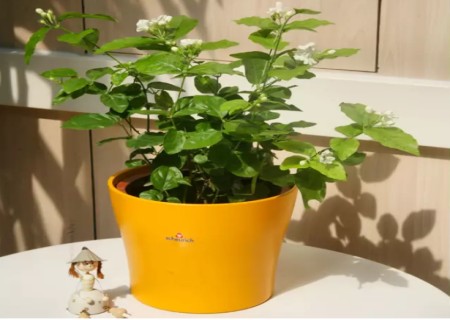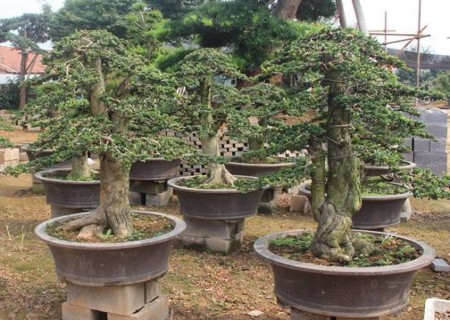Potted jasmine cultivation methods and precautions
The jasmine flowers of evergreen small shrubs have emerald green leaves, white flowers and strong fragrance, which are common ornaments for gardens and potted plants; potted plants are used to decorate the room, elegant and pleasant, and can be processed into garlands and other ornaments; and most of the yellow and fragrant white flowers of deciduous vines are one of the best ways to decorate winter gardens in many foreign gardens.
"the flowers bloom all over the garden, but the fragrance can't beat it." it is the jasmine flower that "one flower can smoke a room of incense". Although the jasmine is not stunning, it has the sweetness of roses, the fragrance of plum blossoms, the seclusion of orchids and the elegance of magnolia. At present, it is the season for jasmine to bloom. In addition to its white color and ornamental value, jasmine has a clear fragrance. For many people who do not sleep well, putting a pot of flowering jasmine in the bedroom can also calm the mind and help improve sleep.

Potted jasmine is easy to raise in spring, summer and autumn, and the season of poor conservation is winter. Potted jasmine culture methods can be summarized by eight-character policy, such as flood, fertilizer and high temperature exposure, as follows:
1. Flood: Jasmine has shallow roots and developed fibrous roots, luxuriant branches and leaves, high temperature and evaporation in summer, and it is not resistant to drought, so the soil can not be too dry, but it should not be muddy. Pots had better use soil basins, plastic pots, porcelain pots with poor air permeability, can be used as a cover basin. The premise of flood is that the soil aggregate structure is good, loose and ventilated. The principle of flood irrigation is to dry and wet, dry and thoroughly irrigate. Note that dryness is by no means dry coke.
2. Big fertilizer: Jasmine has long growth cycle, large annual growth and repeated branches and blossoms, fast nutrition consumption, high energy demand, thin branches and thin leaves and less flowers if the fertilizer can not keep up with it. The premise of big fertilizer is mainly rotten organic fertilizer, which is extremely important, such as rapeseed cake water (topdressing), poultry and fish visceral water (topdressing), supplemented by chemical fertilizers such as potassium dihydrogen phosphate. The method of fertilization is to apply it in the evening on a sunny day during the growing period, return water in the early morning of the next day (crucial), and once a week during the growing period.
3. High-temperature exposure: Jasmine likes the sun very much and must not over-shade. Under the premise of ensuring moisture, full-day sunshine is the best. If there is sufficient sunshine, there are many flowers with luxuriant leaves and leaves, while low-temperature shading means thin leaves, thin flowers and thin branches. In addition, moderate pruning before spring germination and after each batch of flowers can ensure proper density of branches, concentrated nutrition and reduce ineffective consumption.
In addition, the problem of strengthening in the process of maintenance. After five years of growth, the main branches will age, the upper branches will be thin and weak, and the flowers will be small. In the meantime, special attention should be paid to cultivating more native branches at the base, which are strong and properly guided to the old main branches that need to be renewed. after a year of growth, the old branches can be replaced and the soil surface of the old branches can be cut off, so as to achieve the purpose of renewing the main branches and strengthening the trees. maintain vitality.
All right, after introducing the home breeding and fertilization methods of jasmine, let's follow the gardener's uncle to take a look at the other key points and matters needing attention of family potted jasmine.
1. Soil: it is better to cultivate jasmine with fertile sandy or semi-sandy soil. Only by planting in the slightly acidic soil with pH 6.0-6.5, the root system is dense and the growth is strong, while the soil is heavy and has low fertility, the root system is less, the plant is short, the stems and leaves are slender, and the flowers are few and small.
2. Lighting: Jasmine likes hot, humid, ventilated and breathable environment. It needs sufficient light to shine on positive plants for a long time, and it is appropriate to shine for more than 5 hours a day. Jasmine is afraid of the cold. Jasmine can be cultivated outdoors in Central and South China to survive the winter. The north needs to keep warm in autumn. Moving indoors should be placed in the most sunny place facing south. Strong light means strong branches, dark green leaves, many flowers, good coloring and strong fragrance. Therefore, in order to have more jasmine flowers, we must have a good environment and enough light.
3, watering: Jasmine is not resistant to drought, but avoid stagnant water, rainy season should timely eliminate stagnant water in the basin or planting land, otherwise the leaves are easy to yellowing, commonly known as water yellow. In summer, hot and sunny days should be watered twice a day, once in the morning and evening, if you find that the leaves are curling and sagging, you should spray water on the leaves.
4. Fertilization: Jasmine likes fertilizer, high temperature in midsummer is the peak period of jasmine growth, heavy fertilizer, more organic fertilizer and phosphorus and potassium fertilizer, such as matured sesame sauce residue, calcium superphosphate, compound fertilizer and multi-element flower fertilizer are applied twice a week. Families can use kitchen leftovers to add black alum retting liquid fertilizer. The principle of frequent application of thin fertilizer should be grasped in fertilization. Be careful not to apply fertilizer when the basin soil is too dry or too wet. The effect of fertilization is the best when the basin soil is dry and not dry.
5. Pruning: Jasmine grows very fast in summer and should be pruned in time. After pruning, potted jasmine retains the base 10-15 cm to promote sturdy new shoots. If the new shoots grow vigorously, they should pick the heart when growing 10 cm, promote secondary shoots to bloom more, and the plant shape is compact. The flowers should be cut off from the branches after fade to reduce nutrient consumption.
6. Prevention and control of diseases and insect pests: Jasmine is often damaged by shell insects and red spiders, which often invade flower buds, especially from July to September. Can be sprayed with 1000 times phoxim EC, once every half month, 2-3 times in a row.
Note:
Do not spray water on the flowers during flowering to prevent early falling flowers and the disappearance of fragrance. Cover the rain or move the jasmine indoors during heavy rain. The basin should be changed for 3 years, which should be at the end of winter and the beginning of spring. There is no need to cut the root, replace it with new nutritious soil, and put some bone powder and horseshoe slices on the pelvic floor as base fertilizer to pour water through. If jasmine only grows branches but does not blossom, it is due to excessive nitrogen fertilizer and lack of sunlight, such as more phosphorus and potash fertilizer, moved to a place with plenty of sunshine and good ventilation, it is not difficult to bud and blossom.
Time: 2019-05-31 Click:
- Prev

What should I do if the potted camellias lose their leaves?
The autumn wind swept the fallen leaves and swept the camellia leaves of many families to the floor. The strange thing is, just drop it. Just drop the yellow leaves. Why are the green leaves blowing to the ground as well? Recently, several flower friends have consulted us about the loss of leaves of their own camellias.
- Next

How to raise and maintain the bonsai of Phoebe angustifolia
Phyllanthus angustifolia has great ornamental value, and it is also suitable for the cultivation of modeling trees. it is a good garden plant and can be used as hedges and bonsai trees. Chinan likes high temperature, high humidity and plenty of sunshine, so it is better to keep it in full sunshine during maintenance, or in a half-day place.
Related
- Fuxing push coffee new agricultural production and marketing class: lack of small-scale processing plants
- Jujube rice field leisure farm deep ploughing Yilan for five years to create a space for organic food and play
- Nongyu Farm-A trial of organic papaya for brave women with advanced technology
- Four points for attention in the prevention and control of diseases and insect pests of edible fungi
- How to add nutrient solution to Edible Fungi
- Is there any good way to control edible fungus mites?
- Open Inoculation Technology of Edible Fungi
- Is there any clever way to use fertilizer for edible fungus in winter?
- What agents are used to kill the pathogens of edible fungi in the mushroom shed?
- Rapid drying of Edible Fungi

